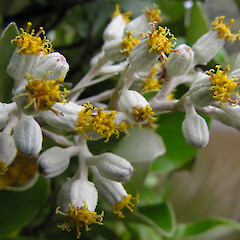Brachyglottis cockaynei
Synonyms
Senecio cockaynei G.Simpson et J.S.Thomson
Family
Asteraceae
Flora category
Vascular – Native
Endemic taxon
Yes
Endemic genus
No
Endemic family
No
Structural class
Trees & Shrubs - Dicotyledons
NVS code
The National Vegetation Survey (NVS) Databank is a physical archive and electronic databank containing records of over 94,000 vegetation survey plots - including data from over 19,000 permanent plots. NVS maintains a standard set of species code abbreviations that correspond to standard scientific plant names from the Ngä Tipu o Aotearoa - New Zealand Plants database.
BRACOC
Chromosome number
2n = 60
Current conservation status
The conservation status of all known New Zealand vascular plant taxa at the rank of species and below were reassessed in 2017 using the New Zealand Threat Classification System (NZTCS) – more information about this can be found on the NZTCS website. This report includes a statistical summary and brief notes on changes since 2012 and replaces all previous NZTCS lists for vascular plants.
Please note, threat classifications are often suggested by authors when publications fall between NZTCS assessment periods – an interim threat classification status has not been assessed by the NZTCS panel.
- Conservation status of New Zealand indigenous vascular plants, 2017 . 2018. Peter J. de Lange, Jeremy R. Rolfe, John W. Barkla, Shannel P. Courtney, Paul D. Champion, Leon R. Perrie, Sarah M. Beadel, Kerry A. Ford, Ilse Breitwieser, Ines Schönberger, Rowan Hindmarsh-Walls, Peter B. Heenan and Kate Ladley. Department of Conservation. Source: NZTCS and licensed by DOC for reuse under the Creative Commons Attribution 4.0 International licence.
2017 | Threatened – Nationally Critical | Qualifiers: RR, Sp
Previous conservation statuses
2012 | Threatened – Nationally Critical | Qualifiers: RR, Sp
2009 | Not Threatened
2004 | Not Threatened
Brief description
Bushy shrub inhabiting coastal scrub of western Nelson. Leaves bright green, longer than wide, paler underneath. Flowers a white furry body with a yellow tip in loose clusters at tips of twigs.
Distribution
Endemic. South Island – Westhaven, West Wanganui Inlet
Habitat
Coastal scrub.
Detailed description
Compactly branched shrub up to 1 metre tall. Branches brittle, more or less purple; branchlets at first pubescent, ribbed. Leaves 4–6 × 3–4 cm., on pubescent grooved petioles up to 2 cm. long, obliquely oblong to obovate, obtuse to subacute; glabrous above, clad below in thin appressed silvery to greyish tomentum, midrib prominent, margins very obscurely toothed. Panicles terminal, branchlets tomentose, lower bracts foliaceous. Capitula sub-cylindric, about 1 cm. long, 4 mm. diameter, discoid. Phyllary narrow-lanceolate, acute to subacute, glabrous, margins scarious. Pistillate flowers usually absent, disk-florets about 20. Achenes 3 mm. long, linear, grooved, pilose. Pappus-hairs barbellate.
Flowering
January – February
Fruiting
February – March
Etymology
brachyglottis: Name comes from the Greek words brachus meaning “short” and glottis meaning “the vocal apparatus of the larynx”
cockaynei: Named after Leonard Cockayne FRS (7 April 1855 - 8 July 1934) who is regarded as New Zealand’s greatest botanist and a founder of modern science in New Zealand
Attribution
Description adapted by M. Ward from Allan (1961).
References and further reading
Allan, H. H. 1961 Flora of New Zealand. Volume I. Wellington, N. Z. p. 755.








